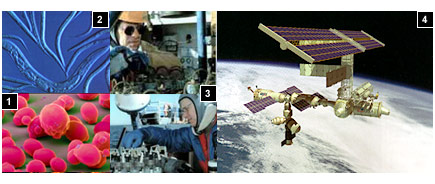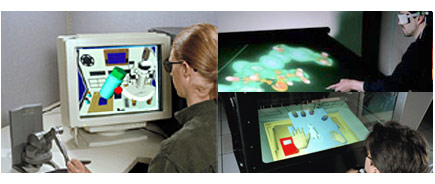|
|

|


|

^ Program

Science & Technology for Life in Space
      
|
|
•
|
Visualization and Simulation for Astrobiology
|
•
|
Gravitational Biology and Life in Space
|
•
|
Astrobiology Technology for Space Missions
|
|

|
Co-Leads:
Emily Morey-Holton, Jeffrey Smith, Richard Boyle,
Alexander Twombly
|
Range of Possible Studies
A range of different kinds of projects are needed to further science and technology for life in space - from studies of life in microgravity to development of new tools and technology to make life in space posssible.
Further understanding of the influence of gravity on life can help complete models of the evolution of life here under Earth's constant 1-G influence and may also help to hypothesize how life may evolve under altered gravity conditions, such as those found on Mars or on other planetary bodies as yet undiscovered. Gravity shapes life. Without gravity, life - from single cells to whole organisms, including humans - adapts, changes and responds differently to the new space environment. This adaptability of life strongly influences the future of human exploration and development of space.

1. 2. Yeast and Nematode Worm, one of more than 10,000 known nematode worm
species, are two of the favored organisms for studies of life in microgravity aboard the International Space Station Laboratory. 3. Laboratory and field experiments 4. International Space Station (ISS) is a scientific laboratory for carrying out experiments on life in space under microgravity conditions.
|
Today, with bioinformatics, genomics and robotic systems, biology is undergoing
revolutionary changes in the information age. The newest tools of the space life
scientist embrace these new technologies, which rely on computational analysis,
data visualization, simulation and automated processing systems that must be
customized for space-based applications. NASA's life scientists continue to develop
and modify new systems for facilitating and improving the quality of space-based
biology research. In the new information age of space biology, automation, simulation
and intelligent systems play a key role in unraveling the mysteries of gravity's
influence on life.
New activities to develop tools and technology to support NASA Missions extend the capacity of astrobiology to serve as an integrator discipline, e.g.:
Simulation Testbed for Robotic Exploration of a Martian Surface
Purpose
This NASA U team will develop a computer simulation testbed for robotic exploration of the Martian surface. With this physically-based software simulation, the team will test a variety of design options for future Mars rovers, including walking and wheeled locomotion systems to search for potential evidence of life. The overall goal is to develop a realistic simulation of biological exploration using autonomous tools at remote sites. To accomplish this goal requires a diverse team of theorists, engineers and biologists. This mission supports the Astrobiology goal to search for life, or the building blocks of life, beyond Earth.

Simulation experiments at the BioVis Lab and other labs at NASA Ames.
Background
A key to discovering life and/or its building blocks beyond Earth lies in the robotic exploration of planetary surfaces. Mars, with its wet, geologically active past, offers an opportunity to search for the building blocks of life close to home. Robotic exploration of the Martian surface has allowed past and present Mars landers to expand their accessible search area beyond the direct reach of sensors and systems attached to the landing craft. But current Mars rovers move too slowly and cannot safely negotiate difficult terrain. Without advances in reliability and capability of robotic rover locomotion systems, the accessible search area for Mars lander missions will be limited.
Research Plan
Four or five Research Associates will be chosen for their potential contribution to a team effort, which aims to produce publishable results in a ten-week period. The team will consist of Research Associates and staff with an appropriate skill mix that spans three major areas: 1) knowledge of biology and the search for life and its building blocks on Mars, 2) engineering of Mars rover systems and 3) software development of physically-based computer simulations. The three Leads for this module have expertise all the major areas required for the success of this research project.
The investigators will assemble a Research Associate team with expertise in the following areas:
- Computer Science: develop C++ software for robotic simulation using current tools available at the BioVIS Technology Center;
- Mechanical Engineering/Robotics: work with real robotic systems and provide input to simulation system with validated robotic data results;
- Neuro-Engineering: develop evolutionary robotics control systems based on genetic algorithms for navigation of simulated terrain and completion of mission objectives;
- Geology/Chemistry/Biology: develop sensor/detector requirements of a targeted
mission, such as a sample return mission to Mars. Use these scientific objectives
to define success criteria for simulated robotic systems.
Research Associates will work as a team with the co-investigators to accomplish the specific objectives of this project:
- Identify current and future walking and wheeled rover designs under consideration for future robotic exploration of Mars, focusing on a future Mars Sample Return mission.
- Identify Astrobiology mission objectives that rovers must accomplish, focusing on a future Mars Sample Return mission.
- Modify existing Mars rover designs in simulation software to include current design considerations.
- Develop self-guided control mechanisms with the simulation environment.
- Identify and design specific sensors for navigational control and for data collection.
- Explore new, original design options considered by the team.
- Perform validation testing of appropriate design options in a Mars-terrain mock-up using design options that have existing hardware to test.
Following are the major deliverables for this project:
- Generalized software simulation testbed and process for performing virtual tests of future robotic Mars rover designs. This system can be used for further testing of robotic rover design and for education/outreach activities to teach Research Associates through robotic design simulation.
- Original, publishable performance data from a variety of virtual rover designs, implementation of biologically-inspired control mechanisms, and the integration of advanced sensor design.
Report and presentation to be submitted for publication at a professional conference.
|
|

|

